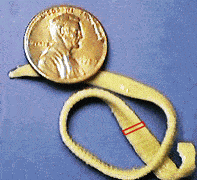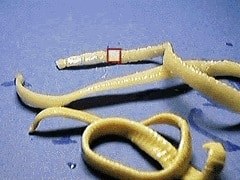
After gaining some pet owning experience, the average pet owner has heard of tapeworms transmitted by fleas and knows to watch for sesame seed-like segments around their pet’s nether regions or on the surface of stools. In fact, there is a part two to this story as there is another type of tapeworm to which dogs and cats are vulnerable. These other worms are members of the Taenia genus.
Our common tapeworm (Dipylidium caninum), article has generated some confusion regarding tapeworms that are not contracted from fleas. There actually is another tapeworm besides Dipylidium whose segments might be seen on a pet’s anal area or on their feces. These other worms are members of the Taenia genus. There are several members of the Taenia genus with which one may come to be acquainted:
- Taenia solium, which infects humans when they consume undercooked pork
- Taenia saginata, which infects humans when they consume undercooked beef
- Taenia hydatigena, which infects dogs when they consume undercooked livestock or venison or feed from dead livestock or deer they find out in the world
- Taenia taeniaeformis, which infects cats when they consume rats and mice
- Taenia ovis, which infects dogs after they consume dead sheep or undercooked lamb
- Taenia multiceps, which infects dogs that eat the brains of infected sheep
- Taenia crassiceps, which infects dogs when they consume rats and mice
- Taenia serialis and Taenia pisiformis, which infects dogs when they consume dead rabbits.
To keep things simple, we will stick to the term Taenia to refer to all them. There are, as you might guess, other Taenia species that infect animals other than dogs and cats but we will leave them out of this discussion for simplicity. In short, pets at risk for a Taenia infection are those that eat raw meat, either through predation or raw feeding.
The Taenia Life Cycle
Note that Taenia tapeworms need two hosts: a dog or cat to house the adult tapeworm and a member of a prey species (see list below) to house the baby tapeworm while it develops. The predator (dog or cat) eats the infected prey to become infected.
The life cycle of Taenia tapeworms starts in the host’s intestine, the host being a dog or cat. The worm can be unbelievably long (up to 5 yards for Taenia hydatigena) and is made of segments. Each segment contains an independent set of organs with new segments being created at the neck while older segments drop off the tail.
As a segment matures, its reproductive tract becomes more and more prominent until it consists of a bag of tapeworm eggs. These segments, called proglottids, are passed with the feces into the world where an unsuspecting intermediate host (mouse, rabbit, deer, sheep etc.) swallows one while eating.
The young tapeworm hatches in the new host’s intestine and escapes into the blood supply with the next stop being the liver. (Remember, this new host is a prey animal such as a mouse, rabbit, deer etc. We have not gotten to the dog or cat predator yet).
The larval tapeworm wanders through the liver, leaving bloody tracks behind. It ultimately falls into the abdominal cavity where it forms a sac and waits. After about two months of development in this location, the larval tapeworm is ready to continue its development but it will need a new host to do so. When the host dies or is killed by a predator, the sac and its young tapeworm inside may be consumed accidentally.
About two months later, inside the predator, the young tapeworm is now mature and is beginning to shed its first segments and the cycle begins again.
How Do you Know What Kind of Tapeworm the Segments Are from?

In most cases, tapeworm segments seen are from Dipylidium caninum, which is not called the common tapeworm for nothing (i.e., it is very common). The segments of Dipylidium are longer than they are wide and are said to look like grains of rice. The segments of a Taenia tapeworm are wider than they are long.
As with most tapeworms, it is hard to find tapeworm eggs using the normal fecal testing we use to screen animals for worm infection. This is because tapeworms shed their eggs in discreet packets (the proglottids) rather than releasing them freely. Unless a proglottid breaks open and releases its eggs, it is likely that eggs will not be found. Diagnosis is usually based on seeing the proglottids with the naked eye.
Is it Important to Recognize Which Type of Tapeworm the Pet Has?

The good news here is that the same medication, praziquantel, kills both types of tapeworms efficiently. Where it becomes useful to know one type of worm from another is prevention. Dipylidium comes from swallowing a flea; Taenia comes from swallowing carrion, hunting prey, or feeding raw food. Knowing where the tapeworm came from tells you what to do to prevent the next infection: stop feeding raw, restrict access to prey or beef up flea control.
Tapeworms do not cause significant symptoms and are largely of cosmetic concern.
If you see tapeworm segments on your pet’s fur or feces, see your veterinarian for a tapeworm treatment.
A note on the Echinococcus tapeworm:
There is a much more dangerous (to humans) genus of tapeworms called Echinococcus. Humans can be infected via contact with canine feces. We bring this up because under the microscope, Taenia eggs and Echinococcus eggs, when they are found, appear identical. They can be distinguished with more advanced testing should this event occur.

